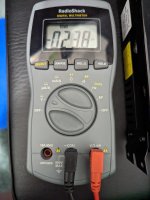Not trying to offend but I would take a moment to watch a few youtube videos about how to use Multimeters we all start somewhere.
It is a little cryptic when your first ever starting with this stuff but its really easy when you understand what is happening and the symbols.
Anyways
You need to set the meter to DC mode which has the V with a solid and dashed line on it (one position below in your video).
When you change your meters mode in the video you will notice the squiggle ~ this is for AC alternating current like what comes out of your wall.
You wont see anything DC really when set to AC mode. Your power supply takes AC from the wall and converts it to DC 5V 12V etc, something useable for electronic boards.
I also would not change modes or turn on your multi meter while power is applied to it but thats just me.
Also and maybe I am wrong as someone else pointed out, it looks like you have your red positive probe on 5V and your black negative probe on 12V.
This really is not advisable at all if this is what is happening. You are shorting your 12V rail to your 5V rail.
The screw terminal marked GND is where your black / Com probe from your meter goes and your Red probe from your meter goes to the voltage you wish to check (IE + 5V DC).
THIS IS FOR DC measurements not AC
Current / Voltages flow from positive to negative / GND. So if you dont have a ground source you wont have a path for electricity to flow properly.
Think of it this way your multimeter is inbetween the path of flowing electricity and your meter is sampling/measuring that flow. So you need to have your source of electricity 5V flowing through your meter to a ground GND.
You should also have something connected to your power supply that is pulling electricity from it maybe a cheap board you dont care about or something.
Some power supplies will not output or do not output fully unless it has a load (something pulling electricity from it)
Your output you measure from the power supply can also vary a little bit depending on the board connected to it because the demand/load of that board can be different. This is another reason to check this way.
I hope that helps you
Edit:
I just realized as well you said you put one probe on +12v and one on -?
Some power supplies have negative voltage terminals. This actually is not a negative in the sense it is ground. Rather its outputting a voltage at a negative value. So for something like -5V DC or -12V DC you still need those to source a ground. IE -12V is not ground for +12V
No offense taken, I appreciate the breakdown.
The video I linked to shows the guy placing the probes in the first two terminals. While my PS is not a suzo happ (
@hatmoose its a RetroArcade MH-16A) it has the same terminal set up as the one in the video.
I was wanting to test it without a board connected because I only have three available to try, two of which I don't want to even run the risk of burning out, and the other I know is a busted board (Neo Geo 1 slot with an Issue I cant recall at the moment). I wanted to get as close to 5 as possible then install it fully and then really put it through a test. If it blows the Neo, no big loss. But I dont want it to even risk blowing the other two boards, a PGM and a Primal Rage.
In the video I posted (of me) I do have the probes reversed, but at first as you can see in the first images, I have them set as the guy in the Youtube video did. Regardless, I dont know where the disconnect/misunderstanding happened because for some reason it worked on his end, but on mine it was all out of whack. That's on me.
My brother in law's MM is reading near 5v now that I have it set to DC as you mentioned.
Like I mentioned, Im not an EE, I just know (quite basically, admittedly) how to use the MM to measure resistance, continuity or voltage. In regard to my MM, I think it really is busted. I tried my MM the same as I did with my brother's and it didn't read anything properly while his did. I think its safe to say that mine is either at end-of-life, or I blew it up with this test at some point. I'd say I got my $20 out of it after 10 years or so lol.
Thanks again everyone, I appreciate it.







 oVGk
oVGk
